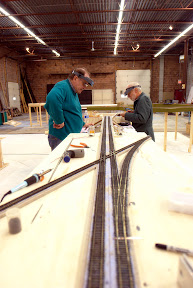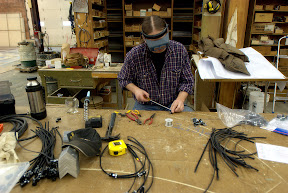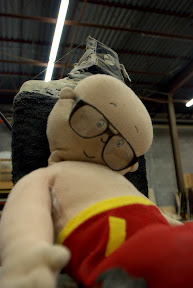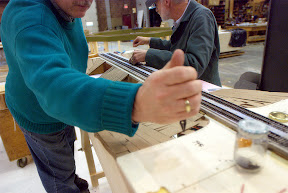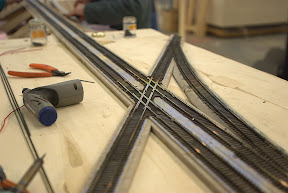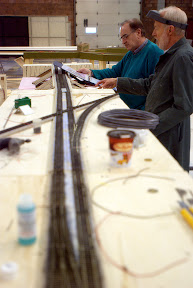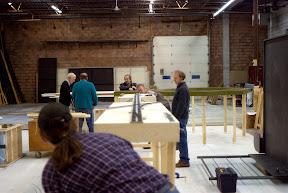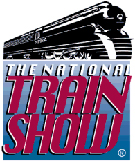Progress on the Free-Mo module.
Over the last week or so I have been plugging away on my latest project, a Free-Mo module of LaSalette, Ontario. Since I have not been able to work on the Bronx Terminal in the last several months for a variety of reasons I agreed to take on a module for the CASO group that I have been posting about lately. I will be returning to the Bronx project soon, but in the meantime this is providing me an outlet for some modeling.
Read More »
For a bit of background of our Free-Mo group and the Canada Southern Railroad read on!
Thanks to Pierre Oliver for forwarding me this information which is posted verbatim below.
-Tim
The CASO – The Canada Southern Railway
The prototype CASO existed from 1872 to about 1995 as an operating railroad. Bits and pieces of it are still in use, but substantial parts of its former mainline have been abandoned and the track lifted.
The CASO was conceived primarily as a bridge route – a short cut between the Niagara and Detroit Rivers over the southwest peninsula of Ontario that would be useful as a link in systems extending between Chicago and the Atlantic seaboard.
The railroad was put together by a group of rather colourful visionaries operating in the usual chaotic fashion in the era of cutthroat competition prevalent in the late 1860’s. Funding to actually construct it was eventually scraped together from various sources after a rival company built a bridge over the Niagara River, thus making access to Buffalo possible. The CASO’s main drive for the first years of its existence was to try and get a CASO mainline over the Detroit River and on to Chicago.
The Railroad was successful in getting across the Detroit River using a combination of ferrying and bridges, and was able to build a subsidiary road that connected Detroit and Toledo. The mainline as constructed and opened in 1872 ran from Fort Erie to Gordon, a hamlet just north of Amherstburg on the Detroit River. A branch line ran along the Canadian bank of the Niagara River and connected Fort Erie to Niagara-on-the-Lake.
The CASO pursued two attempts to get a mainline to Chicago.
A southern route based off the Detroit River built west for a distance, before stalling for lack of cash.
A northern route was also started, running from the mainline just west of St. Thomas, Ontario (which City was the railway’s headquarters and location of its main shops). This route ran to the St. Clair River at Courtright, where a ferry operation took it in to Michigan. A short stretch of mainline was built west from this point, but it too stalled for lack of resources.
The “northern mainline” became instead the St. Clair Branch – the longest of CASO’s branch lines, eventually abandoned in the 1960’s.
This overstretching, plus cutthroat rate wars with the railroad’s chief competition, the Grand Trunk Railway, left the company vulnerable financially and it went bankrupt. Commodore Vanderbilt had been buying up stock while making sure the CASO’s Michigan efforts went nowhere. When the CASO went bankrupt, he was there to buy a controlling interest.
Vanderbilt immediately integrated the CASO in to a secondary “northern” mainline for the NYC. He had the resources, and already had the trackage, to accomplish this task.
By building a cutoff from Welland on the eastern end of the CASO mainline to Niagara Falls and over a new NYC bridge, the NYC could bypass Buffalo.
On the western end of the CASO, the “Essex Cutoff” took the railroad in to Windsor, opposite Detroit, and a better connection with the Vanderbilt-controlled Michigan Central.
Vanderbilt-controlled railroads thus ran from New York and Boston, to the CASO in Buffalo or to its north in Niagara Falls; then across southern Ontario on a very flat profile with lots of tangent and few urban obstacles to Windsor, where traffic was ferried over the Detroit River on to the Michigan Central, which then took the traffic to Chicago via its mainline across southern Michigan.
The original stretches of by-passed mainline became the Fort Erie Branch – which was double-tracked and still had an international connection to Buffalo – and the Amherstburg Branch, which became strictly a short and minor backwater branch line.
By 1910, the CASO/MC/NYC line had a heavy-duty double-track bridge in Niagara Falls, a double-track mainline across southern Ontario to Windsor, and a double-track railway tunnel under the Detroit River to Detroit. This route shaved hours off the time it would take to ship anything – from goods to people – between Chicago and the Atlantic seaboard.
From the 1880’s to the end of the NYC as an independent road, the CASO was an integral part of the NYC system and always received “state of the art” upgrades in operations, equipment, and physical plant.
In addition, the Pere Marquette/C&O/CSX has enjoyed trackage rights over portions of the CASO since 1904.
A profitable CASO branch line to Leamington, Ontario, was constructed in the 1890’s. Also, the CASO interchanged and had junctions with the Grand Trunk (later CN), the Canadian Pacific, and the Wabash/N&W/NS exercising trackage rights over CN.
The CASO also bought the Toronto, Hamilton & Buffalo Railway in partnership with CP and interchanged heavily with this subsidiary.
In addition to the bridge traffic flowing from New York State in the east to Michigan in the West, there was thus interchange and branch-and-on-line traffic generated on the CASO, which was a very busy railroad for most of the 20th century.
As NYC passenger and freight operations declined after the advent of better highways, cheaper cars and trucks, and airline development, the CASO too felt the pinch. Penn Central continued the downward trend for the CASO.
When Conrail was organized, it had enough problems south of the border without getting involved in a morass of “foreign” regulations and problems in Canada. When approached by Canadian National and Canadian Pacific railroads with plans that would assist Conrail operationally by taking the CASO off its hands while at the same time accommodating Conrail traffic, Conrail decided to sell the CASO.
CN and CP did not want nor need the CASO mainline – they each had their own. They did want the Detroit Tunnel and the Niagara bridge, however. Plus, they did not want someone else buying the line and competing with them.
CASO was sold to CN-CP in 1995. They immediately started shifting traffic off the line. The only portion still used on a regular basis is the Detroit tunnel.
Modeling the CASO through Free-Mo
The CASO Free-Mo Group
It is our plan to model prototype scenes of the CASO using the principles of the Free-Mo module standard. With the resources available today and high quality modeling it is possible without too much effort to capture the flavour of the former mighty CASO. To that end we have a number of guidelines to which we expect new prospective participants to adhere.
Guidelines:
All modules are to meet the current Free-Mo standards, as described at http://www.free-mo.org/. These standards include specifications for double-track modules.
All equipment, structures and details should reflect the CASO as it was between 1935 and 1955.
All rolling stock should be correct for the 1935-55 period, and be of high quality with features such as separately-installed grab handles, proper numbering and realistic weathering. Scale couplers and semi-scale wheelsets are strongly encouraged.
Motive power should be reflective of what was used on the CASO in the 1935-55 period.
In the interests of visual continuity, it is strongly urged that all participants utilize the same milled Homasote subroadbed. This will be made available to those building CASO modules (FOB London, Ontario).
To ensure a consistent appearance, the CASO Free-mo group will specify easily obtainable ballast and scenery products, and specify standard colours for items such as fascia paint.
Interested parties can contact us via the Internet:
Pierre Oliver- pierre.oliver@sympatico.ca
Jim Yaworsky- jyaworsky@hotmail.com
Rich Chrysler- richchrysler@quickclic.net
Those looking for prototype inspiration are encouraged to visit www.canadasouthern.com. This web site includes dozens of photographs taken across the CASO system during various eras.

